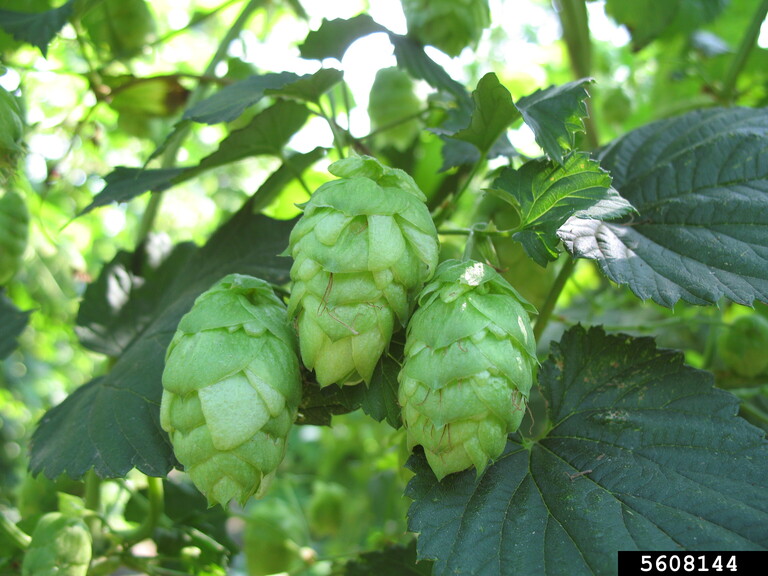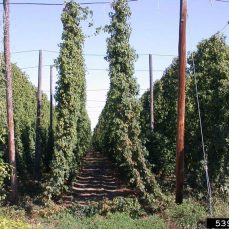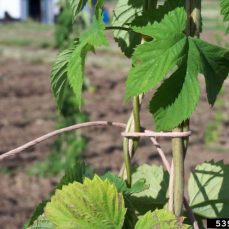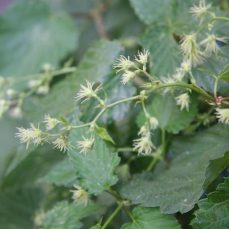
Photo credit: Gerald Holmes, Strawberry Center, Cal Poly San Luis Obispo, Bugwood.org
Management Category
Squamish
Whistler
Pemberton
Vectors of Spread
Overview
Common hops is an invasive species within British Columbia. This invasive is used by breweries to flavour and preserve beer. Common hops is a perennial herbaceous vine that is part of the hemp family (Cannabinaceae).
Synonyms
Common hops is also known as:
- Hops
- European hops
- Bine
ID Characteristics
Flowers: Female flowers lack petals, while male flowers have 5 sepals and short, whitish-yellow stamens.
Stems: Vine-like, often wrapping around a supporting structure. The stem margin may have purple, red, or green stripes. Common Hops can grow up to 10 to 18 m tall.
Leaves: Have a heart-shaped base, with toothed margins and 3 – 5 lobes. The leaves grow 4 – 10cm long and hairy. The leaves grow opposite one another along the stem.
Roots: Large taproot with small lateral roots.
Fruits: Seeds are hidden behind large bracts.
Similar Species
Exotic (non-native, non-invasive)
Japanese hops (Humulus japonicus or H. scandens) have 5 – 7 lobes, while common hops leaves usually have 3 – 5 lobes. Japanese hops bracts are spikier and leave the fruit visible, while common hops fruits are concealed by overlapping bracts.

Japanese Hops by Chris Evans, University of Illinois, Bugwood.org
Habitat and Origin
Common hops is native to Europe and southwestern Asia. It was introduced to BC for agricultural purposes, as its female fruits are used in beer production.
Common hops thrives in partial or full sun; it prefers moist to slightly dry conditions and fertile soil. However, this plant will also tolerate poor, gravelly soil.
How It Spreads
Common hops reproduces by seed. It is a diecious plant, which means that the male and female flowers grow on separate plants.
Common hops also contains rhizomes (underground stems) that allow it to reproduce vegetatively through its roots and stems. Intentional introduction for agricultural purposes is the main vector of spread, as the plant is used by breweries to preserve and flavour beer.
Impacts
Ecological
- Vines grow rapidly and take over natural spaces, often climbing over small trees and shrubs.
- By outcompeting native species, common hops infestations reduce biodiversity.
- Common hops can deplete nutrients in the soil.
Health
- Common hops can cause skin irritation upon contact. It is considered mildly toxic.
Prevent the Spread
Common hops is found in the Sea to Sky region and its distribution is beyond landscape-level control. When common hops is present at high-priority locations and negatively impacting them, their control is considered a high priority.
Otherwise, the goal is to prevent it from spreading to new (uninfested) areas, and to control it where possible to limit its impact on biodiversity.
Learn to identify common hops: Use the images on this profile page.
What to do if you spot it: You can report any common hops sighting by visiting our reporting page.
DO:
- Regularly monitor properties for weed infestations.
- Remove plant material from any equipment, vehicles or clothing used in infested areas and wash equipment and vehicles at designated cleaning sites before leaving infested areas.
- Ensure soil and gravel are uncontaminated before transport.
- Minimize soil disturbances (e.g., use grazing plants that prevent soil exposure from overgrazing), and use seed mixes with dense, early colonization (e.g., alfalfa or barley) to re-vegetate exposed soil and resist invasion.
- Ensure invasive plants (particularly flowering heads or root fragments) are bagged or coveredto prevent spread during transport to designated disposal sites (e.g., landfill).
DO NOT:
- Plant common hops in a garden, no matter how well-contained its enclosure may seem.
- Move soil that has been contaminated with common hops.
- Unload, park, or store equipment or vehicles in infested areas; remove plant material from any equipment, vehicles, or clothing used in such areas and wash equipment and vehicles at designated cleaning sites before leaving infested areas.
- Compost common hops, especially the seeds!
Control
Mechanical:
- Common hops has an extensive root system that must be removed for adequate control.
- Repeated removals of as much of the plant material as possible (including roots and rhizomes) help exhaust the root system.
Chemical:
- There is no specific chemical control recommendations for common hops in BC at the moment.
We recommend that any herbicide application is carried out by a person holding a valid BC Pesticide Applicator Certificate. Before selecting and applying herbicides, you must review and follow herbicide labels and application rates; municipal, regional, provincial and federal laws and regulations; species-specific treatment recommendations, and site-specific goals and objectives.
Biological:
- There is no biocontrol available for this plant.
Sea to Sky Distribution
Common Hops Factsheet
Having trouble viewing the factsheet? Don’t worry, all the information is included on this page. You can also contact us with any questions.
References
- BPlant, Common Hop vs Japanese Hop
- Electronic Atlas of the Flora of British Columbia, Humulus lupulus
- Great Lakes Hops, Growers Notes: Common Issues with New Hopyards
- Hop Growers of America, Weed Management
- Illinois Wildflowers, American Hops
- Korpelainen H. et al., Hop (Humulus lupulus L.): Traditional and Present Use, and Future Potential, in Economic Botany 75, pp. 302-322
- Minnesota Wildflowers, Humulus lupulus
- North Carolina State University Extension Plant Toolbox, Humulus lupulus
- Oregon State University, Growing Hops in the Home Garden
- Outside Pride Seed Source, Hops seeds
- University of Texas at Austin Lady Bird Johnson Wildflower Centre, Humulus lupulus











